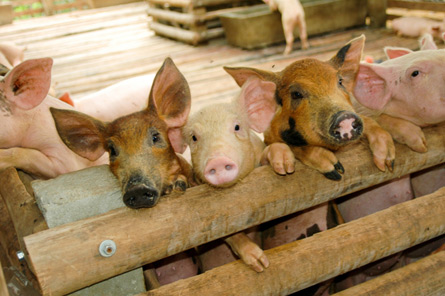Ethanol Fallout: Health Risks for Livestock
With Uncle Sam pushing the production of ethanol for fuel, U.S. corn producers are experiencing an economic bonanza. Not only are they planting more of the grain than at any time since World War II, but the price they receive per harvested bushel has also been skyrocketing. These benefits to growers are proving a juggernaut, however, for meat producers.

Indeed, many livestock operations are getting hit with a double whammy. First, they’re paying more for each ton of corn-derived feed. At least as importantly, a new study finds, the corn product that’s they’re feeding to their animals can be anticipated to carry triple the normal load of fungal toxins.
Because those fungal poisons — or mycotoxins — threaten the health of animals, farmers can look for reduced livestock growth, especially in swine.
The new analysis conservatively estimates the current cost to U.S. hog producers from just one of those toxins, fumonisin, at about $9 million a year. But with wider penetration of this feed additive across species and an accounting for the effects of the other four toxins, that annual loss could easily and quickly swell into the “hundreds of millions, or even billions of dollars,” according to Felicia Wu of the University of Pittsburgh and Gary P. Munkvold of Iowa State University. They authored the new study.
Fungal toxins have become ubiquitous in grains. Corn tends to harbor five major ones: fumonisin, aflatoxin, vomitoxin, zearalenone, and ochratoxin A. Animals can safely dine on corn tainted with low concentrations of these. However, with the price of corn booming, livestock producers can seldom afford to feed their animals corn. Instead, they’re turning to blends of distillery wastes – a dried mix of high-protein solids and liquids. Toxins in corn don’t end up in the ethanol, but instead concentrate in the distillery wastes, and at roughly three times the value in the starting kernels, Wu and Munkvold report.
Their new study, due to be published soon in the Journal of Agricultural and Food Chemistry, bills itself as the “first review of the potential impact to animal health of mycotoxins in dried distillers’ [wastes].”
This economic analysis, based on published toxicity data for livestock, would appear to portend financial adjustments in the corn and ethanol markets. First, it’s likely that greater attention will be paid to fungal-toxin concentrations in grain, Wu and Munkvold argue, with routine testing needed to verify that levels in distillers’ wastes don’t prove lethal to animals.
Corn prices might fall if some share of harvests can’t go for ethanol use owing to high starting toxin concentrations in the kernels. In addition, “Ethanol facilities may lose through not being able to sell [distillery wastes] with excessively high mycotoxin levels, and/or they may need to pay higher prices for maize that is relatively clean,” the authors point out. Finally, livestock producers, “aside from suffering economic losses due to potential animal health effects, may need to pay higher prices for both high-quality maize and high-quality [distillery wastes] for animal feed.”
If some distillery wastes end up linked to animal disease or deaths, the ethanol industry might even encounter a costly “shock event,” Wu and Munkvold suggest. Lawsuits and “media frenzy” from such an event could even lead to new regulations.
Ethanol production is relatively expensive – at least for fuel markets – and most distillers were hoping to recoup big bucks by selling their wastes, meaning they wouldn’t actually prove to be wastes at all. But ethanol producers can’t recycle those byproducts if they’re poisonous. So, here’s another pin threatening to burst the ethanol bubble.
Wu and Munkvold note that there are genetically modified strains of corn under development that appear especially resistant to fungal growth. But GM crops aren’t popular, for a host of reasons.
What I take home: There’s no easy solution to quenching our growing thirst for liquid fuels. My preference: Engineer cars to sip their fuels, not guzzle them. There have been technologies available for years that would allow Detroit – and Japan and Korea and now China – to produce vehicles that get 80 or more miles per gallon.
I’d advocate increasing the tax on liquid fuels – a strategy I admit is at odds with at least two of the presidential frontrunners. As the price of fuel increases, people will suddenly swarm to dealerships offering high-mileage models. Me among them.
Indeed, I was at Argonne National Laboratory, a year ago, touring their plug-in-hybrid-vehicle research facility. (As a Prius owner, I was anxious to see the next-generation technology.) Cars under development could easily get 200 miles per gallon, I learned. And depending on how they’re driven (ie no more than 30 miles a day between charges), it might even be possible to fill a car up at purchase and then never need to visit a gas station again – ever.
Now that’s the car for me.






